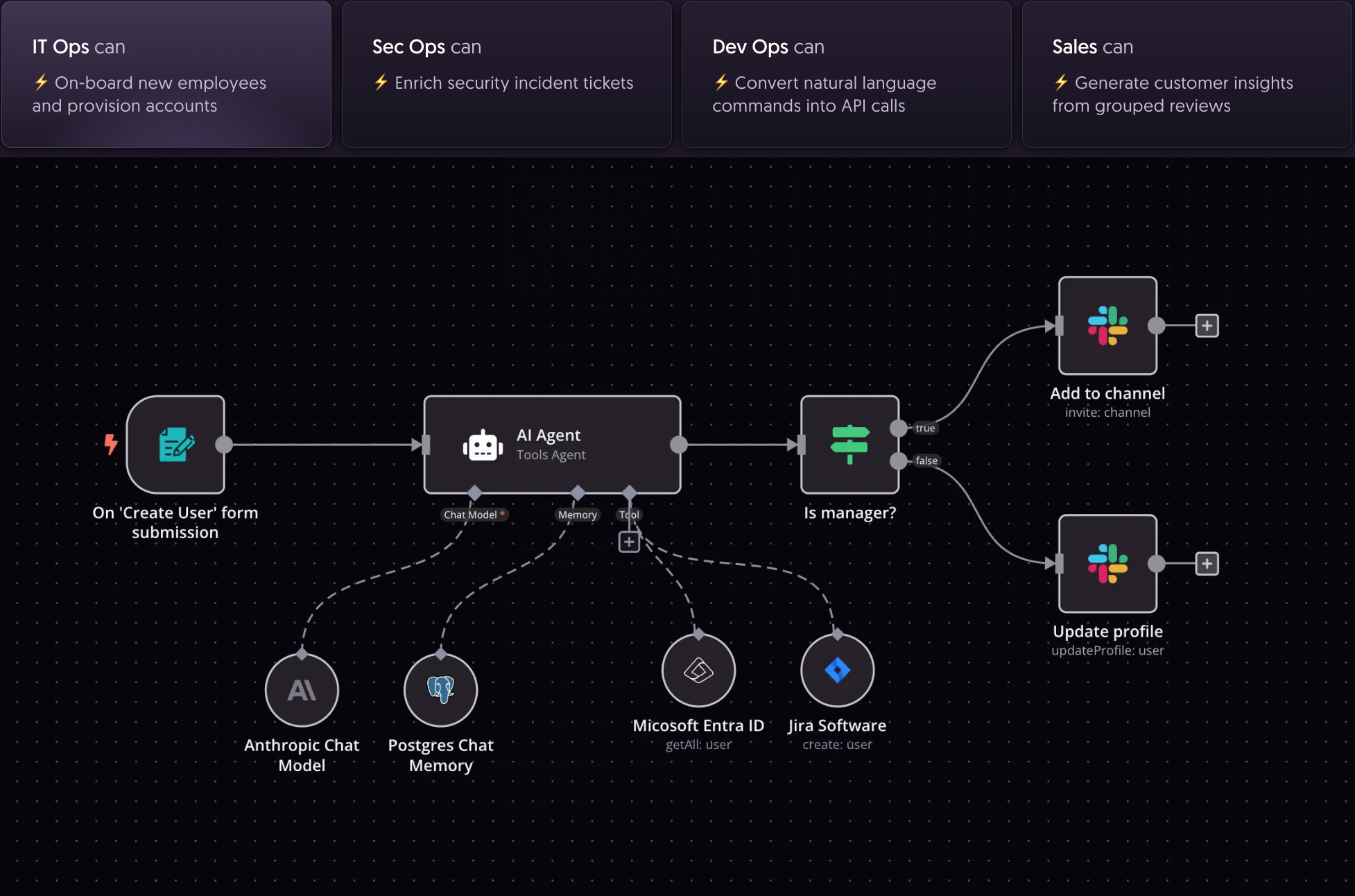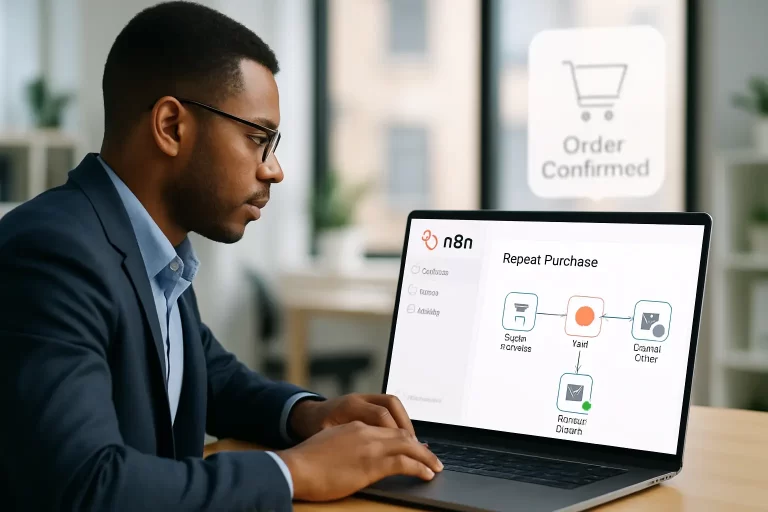Are you a business owner constantly looking for ways to make things run smoother and cut down on costs? In today’s fast-paced digital world, automating your business processes isn’t just a nice-to-have—it’s pretty much a must. Imagine if your team could stop spending time on boring, repetitive tasks and really focus on the things that help your business grow. That’s where n8n comes into the picture. This powerful, flexible, and open-source low-code automation platform is changing the game for businesses of all sizes who want to get serious about n8n implementation for business process automation.
What makes n8n stand out? Well, it’s a low-code automation platform, which basically means it makes automation accessible to almost anyone, even if you’re not a coding whiz. Forget about wrestling with complicated code or paying a fortune for developers! n8n’s easy-to-use, visual workflow builder makes setting up automations surprisingly straightforward. You know, a lot of older automation systems are clunky, require heavy coding, and are just plain inflexible. n8n is a breath of fresh air because it uses a simple drag-and-drop interface and works with a huge range of apps and services. Think of it as your all-in-one digital toolbox for making everything from customer relationship management to data handling more efficient through clever workflow orchestration.
The benefits of business automation with n8n are hard to ignore. When you automate those routine tasks, you’re looking at some serious improvements. We’re talking about better efficiency, fewer mistakes caused by human error, significant savings, and the ability to scale your business without things falling apart. Experts agree on this. For example, Automake.io calls n8n a game-changing low-code workflow automation tool. (Oops, almost slipped up with a buzzword there!). Let’s rephrase that: Automake.io really highlights how n8n can transform your workflow automation. Hostinger also points out how crucial workflow automation is for improving business performance overall. It’s about working smarter, not just harder, and n8n gives you the tools to do just that. Did you know that studies show businesses that embrace automation can save, on average, 20% or more time on those everyday tasks? That’s time you can put back into growing your business and coming up with new ideas.
Harnessing n8n Workflow Automation: A Practical Guide
Ready to dive in and set up your own automations? Let’s walk through a step-by-step n8n workflow setup to get you started with business process automation. It might seem a bit daunting at first, but if we break it down into smaller pieces, it’s actually quite manageable. Trust me, you’ll get the hang of it!
Step 1: Identify Automation Opportunities
First things first, we need to figure out which of those repetitive, manual tasks are eating up your team’s precious time. Take a look at your day-to-day operations. Are there things that just feel like you’re doing them over and over again? Those are perfect candidates for automation! Think about tasks like:
- Entering the same data into different systems
- Creating those daily, weekly, or monthly reports
- Sending follow-up emails and reminders to customers
- Posting and scheduling content on social media
- Moving basic data between different applications
As Automake.io rightly says, “Identifying repetitive tasks” is the very first step. So, take a moment to really look at what your team does and write down those time-consuming activities. You might be surprised at how many things you can actually automate. It’s often more than you initially think.
Step 2: Define Automation Goals and Objectives
Okay, so you know *what* you want to automate. Now let’s think about *why* and *what you want to achieve*. Setting clear, measurable goals is key to any successful automation project. What exactly do you hope to get out of your automation efforts?
- Do you want to cut down customer support response time by 20%?
- Are you aiming to automate the generation of daily sales reports?
- Is it about making your lead nurturing process better to get more conversions?
- Or maybe you want to reduce errors from manual data entry?
Having clear objectives helps you measure success and stay on track with your automation projects. Just like Automake.io advises when “Setting automation goals,” make sure your objectives are Specific, Measurable, Achievable, Relevant, and Time-bound (SMART). This clarity will guide how you design your workflows and how you actually put them into action.
Step 3: Design and Map Your n8n Workflow
This is where n8n’s visual approach really shines! n8n’s interface lets you visually map out your automation workflows using a drag-and-drop system that’s super intuitive. Imagine you’re building with digital LEGOs. You use ‘nodes’ – think of them as individual building blocks that represent different actions or integrations – and connect them to create a logical flow. These nodes can be triggers (like when someone submits a new form) or actions (like sending an email or updating a database).
Designing your workflow means creating a detailed plan of your automated process. For example, a simple workflow might start with a “Webhooks” node (that’s your trigger) to grab data from a form submission, and then go to an “Email” node (an action) to send out a notification. The drag-and-drop interface makes this surprisingly easy, even if you don’t have a tech background. You’re basically doing dynamic workflow creation with n8n, adapting and tweaking your processes as your business needs change. And as Automake.io points out, “Mapping workflows using the visual interface” is a huge plus, letting you see and build complex processes without writing a single line of code.
Step 4: Implement and Test the Workflow
Time to turn your workflow design into reality in n8n! Implementation is all about setting up each node in your workflow, connecting to the services you need (like your CRM or email platform), and defining exactly what actions you want to automate. For instance, in an email automation workflow, you’d set up the “Email” node with your email account details, the email template you want to use, and who should receive the emails.
But hold on, before you let your automation loose on real data, testing is absolutely crucial! Thorough testing makes sure your workflow works correctly and actually achieves what you set out to do. Use some sample data to run your workflow in a test environment, if you can. Look for errors, unexpected results, and double-check that every step works as it should. Automake.io rightly mentions “Testing and training teams,” and while training your team is important down the line, getting the testing right comes first. It’s always better to find and fix problems during testing rather than when your automation is live and running.
Step 5: Deploy, Monitor, and Optimize
Once you’re confident that your workflow is working perfectly in your tests, it’s time to deploy it and let it run in your actual business operations. Deploying in n8n usually means just activating your workflow, which allows it to start listening for those triggers and performing the automated actions.
However, deployment isn’t the end of the road; it’s more like the beginning of ongoing management. Keeping a close eye on things is essential. Monitor your workflow’s performance. Are there any errors popping up? Is it running as efficiently as you expected? Are there any bottlenecks slowing things down? Automation is something you refine over time. As Automake.io advises with “Continuous monitoring and optimization,” regularly check your workflows, look at how they’re performing, and find areas where you can make them even better. Maybe some steps can be made simpler, maybe you need to improve how errors are handled, or maybe you can expand the automation to cover more tasks. Constantly optimizing ensures your automations stay effective and keep up with your changing business needs. Want to learn more? Check out this n8n workflow automation guide for more insights.
Practical Workflow Examples
To give you some clearer ideas, here are a few simple n8n workflow examples you can start using:
- Automating email notifications for form submissions: When someone fills out a contact form on your website, automatically send them a thank-you email and let your sales team know. This can save hours of manual email work each week. Imagine saving 5 hours a week – that’s a lot!
- Syncing data between a CRM and a spreadsheet: Automatically update a Google Sheet with new contacts in your CRM, or the other way around. Say goodbye to manual copy-pasting!
- Automating social media posts: Plan your social media content in advance and use n8n to automatically post to platforms like Twitter or LinkedIn at the best times. You could even create an automated Twitter bot with n8n. If you are interested in social media automation, you can also check out this youtube video about n8n and social media automation.
Inspired by use cases from Automake.io and practical examples from Hostinger, these are just a few starting points. The possibilities with n8n are huge, and these simple examples are a great way to kick off your business automation journey.
Advanced n8n Techniques: Integration, Error Handling, and Best Practices
Once you’re comfortable with the basics, you can explore some more advanced n8n techniques to really supercharge your business automation. This means getting to grips with n8n integration best practices and setting up solid error handling in n8n automation to build systems that are both reliable and efficient. Think of it as leveling up your automation skills!
Advanced Integration Strategies
n8n really shines when it comes to connecting with a wide range of business apps and services. Using its extensive library of nodes, you can link up your CRM, databases, marketing tools, and use API integration for tons of other services. This lets you build truly connected and automated business processes. For example, you can explore advanced tutorials, such as this one about n8n AI integration.
When you’re integrating with APIs, keep in mind some key best practices. Make sure you’re using proper authentication, understand and respect API rate limits (Hostinger mentions this in the context of API rate limit handling), and know how to transform data between different systems. Webhooks are another powerful tool for getting real-time data triggers. They allow your workflows to react instantly to things happening in other applications, making your automation dynamic and responsive. Want to see some real-world examples? Check out these n8n workflow examples.
Robust Error Handling Mechanisms
Even the best-planned workflows can run into problems. Network issues, API outages, or unexpected data can all cause interruptions. That’s why good error handling is so important for building n8n automations that you can rely on. Here are some essential techniques for error handling in n8n automation:
- Retry on Fail: Use the “Retry on Fail” node (Hostinger highlights this) to automatically retry operations that fail, which is especially useful for temporary network glitches.
- Conditional Logic (If/Else nodes): Implement “If/Else” nodes to handle different scenarios based on how your workflow is running. For example, if an API call fails, you can trigger a different set of actions.
- Error Notifications: Set up error notifications to immediately alert administrators via email or Slack if a workflow fails. This means you can jump in and fix problems quickly.
- Error Logging: Use error logging to keep detailed records of workflow failures for debugging and deeper analysis, as Hostinger emphasizes with “error monitoring and logging for debugging.” This helps you spot patterns and proactively deal with ongoing issues. You can find more information about error handling and debugging in this n8n quickstart guide.
By proactively including these error handling techniques, you can really improve the robustness and reliability of your n8n automations. It’s about building systems that can handle hiccups and keep running smoothly.
Workflow Optimization and Best Practices
To make sure your n8n workflows are not just working but also efficient and easy to maintain, follow these best practices for n8n integration best practices:
- Modular Workflow Design: Break down complex workflows into smaller, independent parts. This makes it much easier to update, troubleshoot, and reuse components. Think of it like building with modules – easier to manage and change.
- Clear Naming Conventions: Use clear and descriptive names for your nodes and workflows. This makes it easier to understand and manage your automations, especially when you’re working in a team. Good naming saves headaches later!
- Environment Variables: Securely store sensitive info like API keys and passwords as environment variables instead of putting them directly into your workflows. This improves security and makes it easier to manage configurations across different environments.
- Regular Review and Optimization: Periodically review your workflows and look at their performance data. Find bottlenecks and areas for improvement to keep your automations running smoothly. Automation isn’t “set it and forget it” – it’s “set it, monitor it, and improve it.”
- Proper Documentation: Document your workflows thoroughly! Clearly explain what each workflow does, how it works, and any important settings. This is crucial for team collaboration and for remembering how things work in the future. Imagine your future self thanking you for good documentation!
For those looking to push the boundaries even further, explore advanced features like dynamic workflow creation with n8n using n8n’s API. You might even find inspiration from the n8n Community article on “An Automated Process to Create Workflows in n8n.” The possibilities for innovation are constantly growing. If you want to dive deeper into workflow creation, you can also check out this youtube video about creating n8n workflows or read this guide about n8n workflow automation.
Future-Proofing Your Business with n8n Automation
Implementing n8n for business process automation is more than just fixing current problems; it’s about setting your business up for long-term success. By making your operations more efficient, saving you money, and improving your ability to scale, n8n helps you become a more agile and competitive business. Its open-source nature, flexibility, and strong community support mean it will keep evolving and adapting to the ever-changing digital world. If you are part of a team and want to know more about collaboration, check out this resource about automated process to create process in n8n.
The trend towards business automation is speeding up fast. Industry experts predict huge growth in the automation market in the coming years, with some estimating it will be worth over $300 billion by 2026. Businesses that embrace automation early are putting themselves in a great position for lasting success. And what about the return on investment? Well, companies that implement automation solutions often see significant returns, with studies showing an average ROI of 150% or more within the first year. That’s a pretty compelling reason to explore n8n and what it can do for your business. Ready to get started quickly? You can even try the n8n quickstart guide.
So, are you ready to unlock your business’s full potential and stay ahead of the competition? Take a look at n8n, play around with its flexible workflows, and see how this platform can really change the way you do business. The future of business is automated, and n8n is your key to getting there. Start your automation journey today! If you want to learn more about the impact of automation on conversion rates, check out this article about conversion rate optimization.




